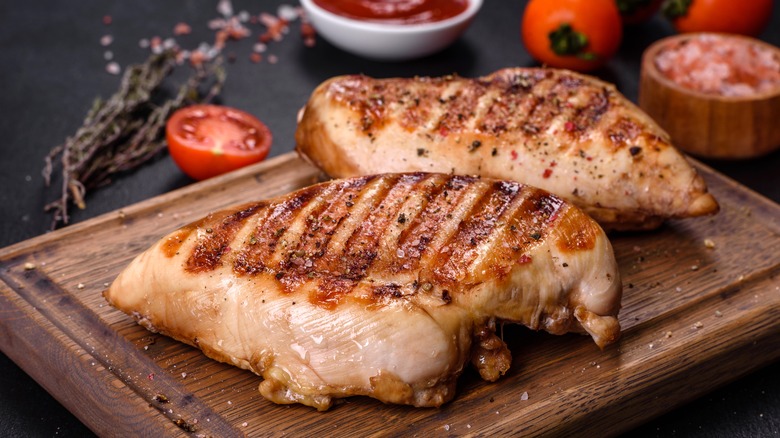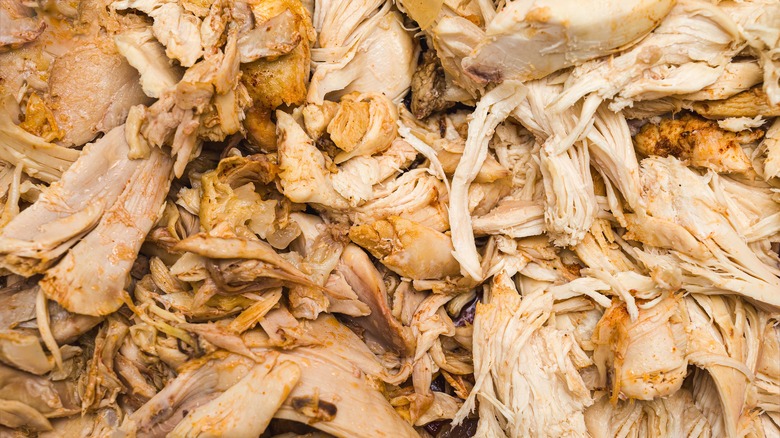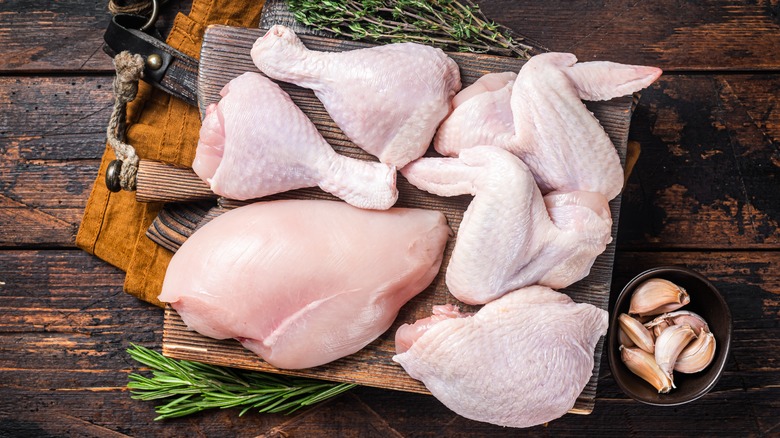Why Is Chicken Considered To Be Both White And Dark Meat?
Types of meat are categorized not only by animal, but also by color. "Red meat" is used to describe beef and pork, but both "white" and "dark" meat are present in poultry. The distinguishing factor between these two categories comes down to where in the body the meat is located, and the concentrations of vitamins, fat, and other nutrients within.
In chickens and other fowl, dark meat can mainly be found in the legs and thighs, while white meat is cut from the breast and wings. White meat is leaner and less nutrient-dense, while dark meat is higher in fat and therefore juicier. Both types have their pros and cons, and can be equally delicious when prepared with care.
The legs and thighs of domestic birds like turkeys and chickens have a lot of heavy lifting to do. Because these animals don't fly as much as they walk, the muscles in their lower body need more oxygen than their wings and breasts. A red-colored protein called myoglobin helps transfer oxygen from the blood to the muscles; the more often a muscle is used, the more myoglobin it contains.
Conversely, the white meat found in the upper body is markedly lower in this pigmented protein, making it lighter in color and taste. This isn't a hard rule for all birds, however. Ducks and geese have darker breast and wing meat because they spend more of their time flying, and therefore have more myoglobin in those muscles.
How white and dark meat differ in nutrition and flavor
Blood flow and protein concentration give cuts of dark chicken meat their characteristic reddish color, and also contribute to a higher iron, zinc, and B vitamin content than white meat. Because more nutrient-rich blood courses through these dark muscles, they wind up with these higher levels. In fact, dark meat can have as much as twice as much zinc as white meat per serving; this nutrient is vital for supporting your immune system and overall health.
White meat cuts like chicken breast don't benefit from plentiful blood flow, but are often touted as a nutritious protein, source since they are so low in saturated fat. Because of its fat content, white meat is more prone to drying out when cooked, and has a milder flavor than dark meat. But don't think you need to suffer through dry white meat in order to follow a healthful diet: There are plenty of ways to prepare chicken breast that help preserve its juices and bring out its natural savoriness.
Some cuts of white meat also come across as more fatty-tasting. Chicken wings, while considered white meat, tend to have a higher fat content because they are usually eaten with the skin on, making them an especially flavorful finger food (and if you're not reheating your chicken wings in the oven, it's a must-do to avoid drying the meat out).
The best ways to cook white and dark meat
Appreciating both types of poultry meat comes down to using different techniques for each cut. When cooking chicken breast, look for recipes that preserve its moisture. Breasts are well-suited to both grilling and baking (try our Nashville hot grilled chicken), and brining the meat is one simple way you can keep your poultry tender. White meat is also great in recipes in which it's cooked in a broth or sauce, as the extra moisture makes the chicken seem more juicy.
The arguably more versatile dark meat, including cuts like chicken thighs, can be quickly pan-seared for a satisfying dinner. Other ways to use chicken thighs include marinating it to capitalize on its natural umami flavor; a hot sauce marinade makes for great spicy chicken sandwiches, or simply marinate it in vinaigrette and use as a salad topper. Or, try the popular Latin American preparation of pollo asado (meaning grilled chicken), made with cuts of dark meat marinated in citrus and spices.
Chicken thighs can also be baked, in which case it's best to leave the skin on and the bone in; the skin insulates the meat from drying out, while the bone helps it cook evenly. Whether you're a fan of white meat or dark, you can surely find a way to appreciate the parts of a chicken that usually aren't your first choice.



